Hip Osteoarthritis
What you should know
Osteoarthritis (OA) is a normal age related change that occurs at the joints. It tends to happen earlier in joints that carry more weight through them. This is why the hip is more commonly affected.
Everyone’s joints go through a normal cycle of damage and repair during their lifetime. Cartilage becomes thinner, the body tries to repair the joint by remodeling and new bone growth occurs to try and stabilise the joint. This remodeling can change the shape or structure of the joint.
Predisposing factors of OA:
- Age - over half of people over 65 show changes on an x-ray however this does not necessarily correlate with symptoms
- Gender - more women are affected than men
- Genetics - they play a small part in OA
- Weight - extra weight through joints can contribute to the onset of joint pain and also speed up the progression of it
- Previous injury - major injuries such as fractures or surgery can lead to joint changes later on
- Occupation - certain occupations are associated with OA e.g. plumbers are more likely to have hip pain
Symptoms
- Pain
- Stiffening of the joint
- Weakness of the surrounding muscles
- Reduced mobility or difficulty with functional tasks such as ascending the stairs
- Difficulty bending down and putting socks/shoes on
- Difficulty climbing stairs
- Difficulty getting in and out of the car
You may not present with all of these symptoms all of the time, everyone is different and at a different stages of condition.
What to do
One of the most important things is to keep moving, many of you may be reluctant to do this due to the pain. However, movement can lubricate the joint, reducing the stiffness, pain and swelling. Move little and often, try and avoid sitting for long periods of time. Get up every 30 minutes and have a walk around to maintain the mobility within the hip joint.
It may be necessary to pace your activity, take regular breaks this will help prevent you doing too much at once and flaring the joint up. Attempt some mobility exercises to maintain the range of movement in the joint and prevent further stiffness. Attempt some strengthening exercises to help build the muscles around your hip, this in turn will offload the joint itself and reduce your pain. (Please see exercises at the bottom of the page).
Be guided by your pain, pushing through your pain may result in a set back and possible flare up.
Continue performing your normal activities but perhaps think about adding some breaks or reducing the time you are performing that activity. When getting in and out of the car/bed, swing both legs in/out together rather than rotating one at a time this will make the transfer easier for you. Try and avoid sitting in a low chair where your hips are above your knee as this may cause more pain. Try and avoid lifting heavy weights, use a trolley when shopping where you can.
Pain medication
It may surprise you, but simple over the counter painkillers such as paracetamol and ibuprofen are the most effective pain medication. If you feel you need them – use them. You should only take the recommended daily dose but do not wait until your pain is out of control to take them.
Consult with your GP if you have any concerns and do not take ibuprofen or aspirin if you are pregnant or have asthma, an ulcer or indigestion.
Sleep
Sleep is really important when it comes to managing pain. Studies suggest that getting a good night sleep can reduce pain levels by as much as 25%.
Tips to improve your sleep include:
- Sleeping in a dark, quiet and cool room
- Try taking pain relief an hour before you go to bed
- Do not consume caffeine within six hours of sleeping
- Try to avoid eating within two hours of sleeping
- Try not to be in front of bright screens such as TVs, laptops or phones for one hour before bed
- Keep your bedroom as a place to sleep - do not use it for work or as an office
- If you do wake in the night and cannot get back to sleep - get up, go to another room and do something until you are tired enough to sleep
Diet and nutrition
If you’re overweight you should consider eating a well-balanced and healthy diet which is low in saturated fats, sugar and salt. It’s also a very good idea to eat plenty of fresh fruit and vegetables, and to drink plenty of water. Diet is important alongside performing some gentle exercise.
If you need to lose weight, the key is to regularly burn off more energy than you consume on a daily basis.
Relaxation
Stress can increase the pain you experience. One way of reducing the effects of stress is to learn how to relax.
There are many relaxation, meditation or mindfulness tapes, CDs and MP3 downloads available – your doctor or physiotherapist may be able to offer you some, or they’re available online or from high-street shops. A good example is Headspace which is available online or as an application for your smart phone or tablet.
Exercises
If exercises are painful to undertake or causes a moderate to high level of pain during or afterwards then reduce the difficulty level or stop that particular exercises.
An episode of hip pain may respond to a small amount of rest but no more than a couple of days. Gentle exercises will avoid the hip becoming stiff and your muscles weakening.
Start some gentle exercises as soon as you are able to this will restore your range of movement, promote strength, ease stiffness and optimise your function.
These exercises below are aimed to stretch, strengthen and stabilise the structures that support your hip.
- Bridge - lie on your back with your knees bent approximately 60 degrees. Squeeze your tummy and your bottom and raise your bottom off the bed. Hold for 5-10 secs and repeat 5 times.
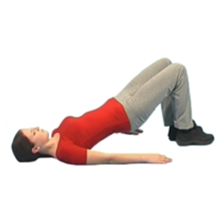
- Sit to stand - shuffle your bottom to the edge of the chair and place your arms across your chest. Take your feet back behind your knees. Lean forwards and stand up. Repeat 5-10 times.
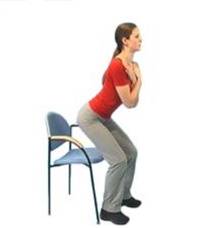
- Hip abduction - stand holding onto a chair. Squeeze your bottom and take your leg straight out to the side and then back into midline. Reapeat this 10 times.
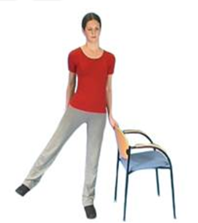
- Hip extension - stand holding onto a chair. Squeeze your bottom and take your leg straight behind and back to midline. Repeat this 10 times.
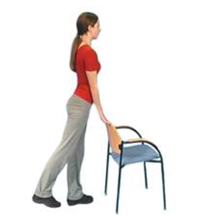
- Hip flexion - stand holding on to a support if you need to. Raise one leg as high as possible with pain limits. Hold it for a couple of secs and then lower it to the ground. Repeat with the other leg. Repeat 10 times.
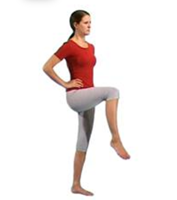
- Hip external rotation - lie on your back knees bent hip width apart. Turn your soles to face each other and allow your knees to fall out and feel the stretch in your groin. Keep your back flat on the floor. Repeat 5 times.
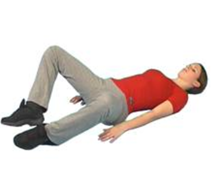
When to see your GP/Physiotherapist
- If you have had a fall or injured your hip
- If you have redness or swelling around the hip
- If you feel feverish or unwell or you’ve been losing weight
- If you are having difficulty with everyday activities for example; climbing the stairs, putting your shoes/socks on and the exercises are not improving your pain after 4 weeks
Further resources
- NHS Conditions - Osteoarthritis
- Escape Pain
- Versus Arthritis - Hip OA Information Booklet
- NHS - Sleep problems
- NHS - Lose weight (includes the NHS app for weight loss)
- NHS - Quit smoking (includes the NHS quit smoking app)
Authors: Jemima Cope, Jane Leah, Catrin Astbury and Cianán O’Sullivan
Review Date: July 2024